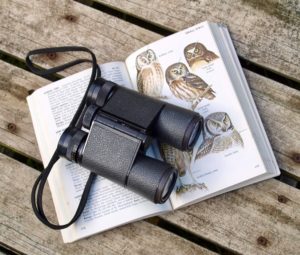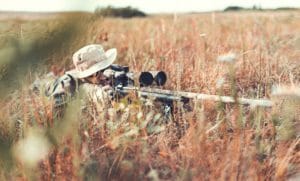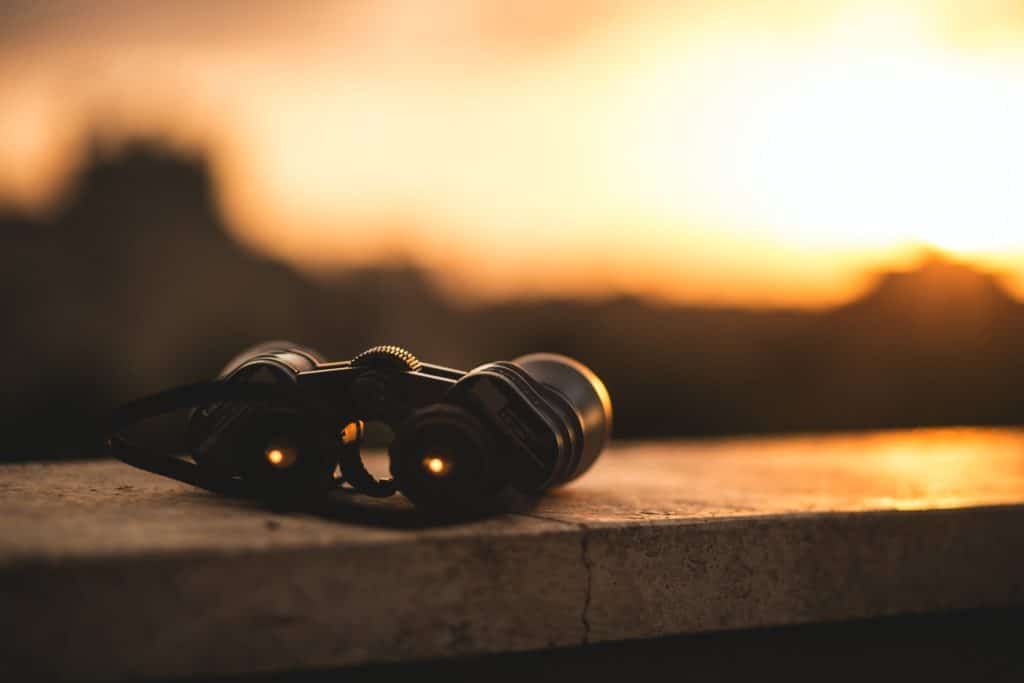Introduction
Image stabilized binoculars have a built-in mechanism that decreases the motion of the image due to binocular movement. They’re designed to minimize hand shake and provide the best view possible, even when you or the viewed object is moving, or you are at maximum zoom.
Image-stabilized binoculars are perfect for use when viewing from moving objects such as planes or boats, and are ideal for zooming in close when hunting, bird watching, and sometimes even stargazing.
Major brands that make high-quality image stabilization binoculars include Nikon, Canon, Fujinon, and Carl Zeiss.
Finding the most suitable image-stabilized binoculars for your needs can be quite a challenge, especially if you’re not an expert and don’t know what exactly to look for.
If you’re looking to purchase a pair yourself and can’t decide which to choose, check our buyers guide below, followed by our review of the seven best and most popular image-stabilized binoculars currently available on the market.
If you want to go straight to the products, here’s our top 7 selection:
- Canon 12X36 Image Stabilization III Binoculars Best Overall
- Fujinon Techno Stabi TS1440 14x40 Image Stabilization Binoculars Best For Travelling And Outdoors
- Canon 10x30 Image Stabilization Binoculars Best Value For Price
- Zeiss Carl Optical 20x60 Image Stabilization Binocular Best For Professional Use
- Canon 18x50 Image Stabilization All-Weather Binoculars Best All-Weather Binoculars
- Fujinon Techno Stabi TS12X28 Image Stabilization Binoculars Best Vibration Reduction
- Canon 10x42 L Image Stabilization Waterproof Binoculars Best For Navigation
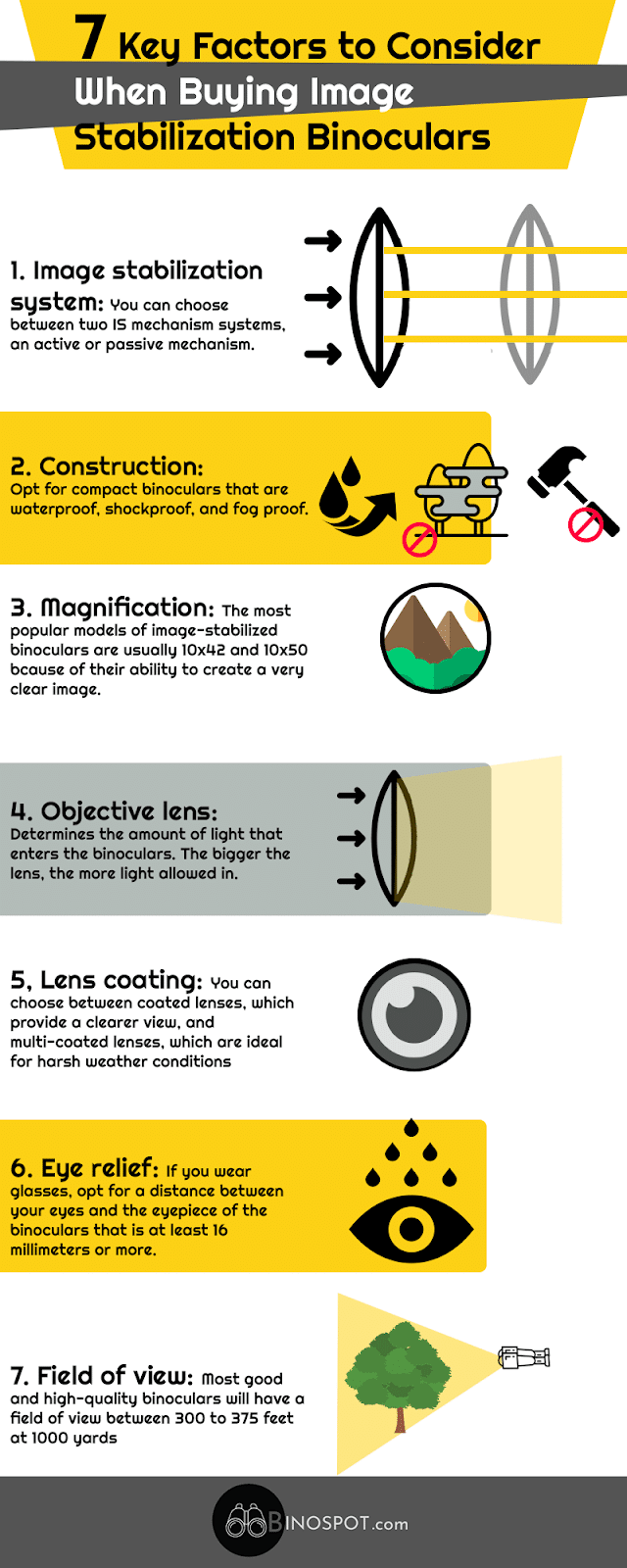
7 Key Factors To Consider When Buying Image Stabilization Binoculars
1. Image Stabilization System
When you’re deciding on which image stabilization binoculars to buy there is a choice of two types of image stabilization systems. You can either choose an active or a passive mechanism.
Both systems are great for observing moving objects, but there’s a slight difference between them.
The active mechanism uses an electronic sensor to steady the picture, and the passive one uses a gyroscope to stabilize the image.
The image-stabilized binoculars with an active mechanism may require you to continuously press down a button as you focus, to maintain your stability of view. The passive mechanism automatically calibrates with the use of the gyroscope to keep a steady view.
2. Construction
When buying a new pair of image-stabilized binoculars, ideally opt for waterproof, shockproof, and anti-fog ones.
This way, you’ll never have to worry about the weather conditions you’re in when using your binoculars. The only problem with this is that binoculars with these qualities tend to be more expensive.
The chassis of the binoculars should be made of quality materials and ideally have a rubber easy-grip coating.
3. Magnification
The most popular models of image-stabilized binoculars are usually 10X magnification, either 10×42 or 10×50, because of their ability to deliver the clearest image. But you can opt for different magnification, depending on what you’ll use the binoculars for.
For example, for general use, we recommend you buy 10×40 binoculars. For bird watching, the most common are 8×42 binoculars. Simultaneously, you’ll need a higher level of magnification for astronomy, so it’s best to opt for 20×70 binoculars to get the best viewing experience.
4. Objective lens
The objective lens is what determines the amount of light that enters the binoculars. It’s denoted on the casing after the magnification, so 10×40 binoculars have a 10x zoom and a 40mm objective lens diameter. The bigger the lens, the more light it will allow in.
5. Lens Coating
It doesn’t matter what type of binoculars you choose, the lens coating is one of the most important factors to consider when buying.
Lens coatings control the amount of light that can pass through a lens, which determines how sharp and clear the image will be.
Look for image-stabilized binoculars that come with, at least, fully-coated lenses. Binoculars with multi-coated lenses are more expensive but better when the view is not as clear, and there is less available light due to cloud, fog or rain.
6. Eye Relief
The distance between the eyepiece of binoculars to your eyes is the one that determines if the eye relief is good or bad. It’s important to choose binoculars with long-distance eye relief, especially if you plan to view through them for more extended periods.
This is even more important if you wear glasses, as poor eye relief will restrict what you see through the lens. Opt for binoculars that have an eye relief distance of at least 16 millimeters.
Interpupillary Distance, or IPD, is the distance between the eyes. A good pair of binoculars will allow you to alter this to suit the user.
7. Field Of View (FOV)
Most good and high-quality binoculars will have a field of view between 300 to 375 feet at 1000 yards. The higher the number of feet per 1000 yards gets, the less zoom capacity binoculars will provide.
Since they make image stabilization binoculars specifically for observing moving objects and preventing shaky images while zoomed, we recommend that you stay between those two numbers for best overall use unless you have a specific purpose requiring a different ratio.
Uses Of Image Stabilizing Binoculars
Since Image stabilizing binoculars are on the pricey side, it’s good to know their best uses. Like most things in life, the more you pay, the more you get, but they also need to fit your personal specifications for how you intend to use them.
Astronomy
Even finding the moon, and holding still while viewing it, can be difficult, so image stabilized binoculars are ideal for keen amateur stargazers who want to scan the sky without the shake.
Sailing
When the boat or ship is constantly moving, and you with it, it can be hard to maintain a clear view, even of scenery on a nearby shore. So, you need the stability that image stabilized binoculars can provide to better determine and fix on what is in the distance.
Birdwatching
People who often watch birds, either for personal or professional purposes, will often use image stabilization binoculars. Birds are constantly moving, and zooming in to see them more clearly can cause a mega-shake. You usually can’t get the sharpness you need with standard binoculars.
Hunting
Like birdwatchers, hunters need to concentrate or lock on a fast-moving animal and maintain a clear view of it.

Reviews Of The 7 Best Image Stabilized Binoculars
1. Best Overall
These Canon binoculars use optics technology to offer superb image stabilization and a high magnification of 12x, all with an affordable price tag.
They’re lightweight and easy to carry, ideal for bird watching, traveling, and watching fast-moving sports events.
The EF lens optics are coated with Canon’s Super Spectra coating. This multi-layered anti-reflective lens coating provides a vibrant, high-contrast view, accurate color rendering and eliminates unwanted internal reflections that cause image duplication and glare.
Porro II Prisms help to provide outstanding image resolution and a wide field of view.
The Canon 12×36 Image stabilization binoculars are designed for simple, durable, and comfortable use.
They have a superior grip and a large rubber eyepiece for a comfortable, balanced view. A handy image stabilizer button and liquid focus ring are easily accessible with the fingers of both hands.
These Canon image-stabilized binoculars are our best overall pick as they offer a wealth of features at a great price when compared to many other similar image stabilization binoculars.
Pros
- Wide field of view.
- Porro ll Prisms.
- Long eye relief.
- Low-reflective exterior design.
- Compact design for simple and comfortable use.
- Long-lasting batteries.
Cons
- Don’t perform well in low-light environments.
- Customers complain of rubber coating becoming sticky over time.
2. Best For Travelling And Outdoors
The Fujinon Techno Stabi TS1440 image-stabilized binoculars with their five degrees vertical image stabilization allow you to lock in on a subject and create a stabilized and wide field of view at high magnification.
You activate the image stabilization function by pressing a button to deliver a stable image. They can even be used for tactical situations, as the stabilization function is silent when activated.
A rubber armor surrounds them, which allows a firm grip on them at all times. The multi-coated lenses help to minimize chromatic aberration and deliver to you clear and sharp views.
The Fujinon Techno Stabi binoculars are both waterproof and fog proof, so you’ll be prepared and ready to use them in any weather.
Pros
- Waterproof and fog proof.
- Strong rubber armor for a firm grip.
- Multi-coated lenses for good image clarity.
- Long battery life.
- Five degrees of stabilization.
- No noise when the stabilization function is activated.
Cons
- Short eye relief.
- Hard to use for beginners.
- Heavy, bulky, and uncomfortable to hold.
3. Best Value For Price
The new superb image stabilization optics technology on these Canon 10×30 image-stabilized binoculars allow you to quickly and accurately eliminate many types of vibrations and movement.
It even corrects vibrations that occur during rotation when you follow an object or observe it from a moving vehicle.
They’re lightweight and compact with 10x magnification, making them easier to bring along with you for traveling, bird watching, and sports such as horse and motor racing.
The double field-flattener lenses correct the curvature of the field, which results in a sharper image display, with an even and wide field of view.
The long eye relief helps ensure comfort while the binoculars are in use, and it prevents additional exhaustion for the eyes, especially for those who wear glasses.
Pros
- Lightweight and compact compared to other IS binoculars.
- Good optical quality.
- Good for eyeglass wearers.
- Easy to focus on the image.
- Stylish looking.
- Covered with rubber to prevent slipping.
Cons
- Poor performance in a dark environment.
- The rubber coverage becomes sticky over time.
- Not entirely waterproof.
4. Best For Professional Use
Simply one of the best products of this type on the market—and their price reflects this. They’re professional-grade binoculars with high-performance optical lenses and 20x magnification.
The Zeiss Carl Optical 20×60 Image Stabilization Binoculars use a mechanical stabilizing system via the use of gyro technology,
They’re not your average binoculars. They allow you to lock an image into place with a simple press of a button providing unmatching detail recognition at ultra-long ranges.
However, at almost three and a half pounds in weight, they are on the heavy side for extended use without support.
Nitrogen-filled air cells within the tubes ensure the binoculars never fog up, so moving from high temperatures to low or visa-versa is not problematic.
While stylish to look at, these durable binoculars have a solid construction and are both waterproof and shockproof. With proper care, these will last a lifetime.
Pros
- Very wide field of view.
- 20x magnification.
- Image stabilization with gyro technology.
- Very durable.
- Waterproof and shockproof.
- Coated premium lens for sharp and long-distance imagery.
Cons
- Very high price point.
- Big and quite heavy.
5. Best All-Weather Binoculars
Canon built their all-weather binoculars incorporating their own IS technology and then designed them especially for the outdoors, with a non-slip rubber coating to withstand harsh environments and perform well in heavy rain.
Their high-power magnification and 50mm objective lens make them suitable to be used for a range of purposes. Their closest focusing distance is 19.7 feet, and they have an eye relief of 15mm.
The lenses are multi-coated and provide excellent contrast, color fidelity and clarity. Canon boasts a very wide apparent field of view (FOV) for these binoculars of 66.6, that’s 194 feet at 1000 yards.
These image-stabilized binoculars are made for all-weathers. Their anti-fog eyepieces prevent fogging and condensation in cold, humid and warm conditions. They are also shock and water-resistant, although not waterproof, and we couldn’t find a specific Ingress Protection rating,
Pros
- Wide and extra-bright field of view.
- Excellent image quality.
- Water and shock-resistant.
- High magnification.
Cons
- High price point.
- Bulky.
6. Best Vibration Reduction
These Fujinon image stabilization binoculars come with a reliable vibration reduction system and a 3 degrees range vibration correction, making them perfect to use anywhere—on land, sea, or air. The IS system will run for up to 12 hours on a CR2 lithium battery.
Multi-coated lenses offer a brighter view and higher resolution, and the phase-coated prisms give a sharp and high contrast image. The compact, lightweight and ergonomic design makes them perfect for viewing for long periods.
Because they’re so lightweight, they’re easy to carry around and are ideal for birdwatching, sports events, concerts or astronomical use.
Pros
- All-weather design.
- Compact and lightweight construction.
- Center focus wheel.
- Good vibration reduction.
- 12x magnification.
Cons
- Fog up in extreme cold weather conditions.
- Small objective lens.
7. Best For Navigation
These Canon 10×42 L binoculars, with an electronic image stabilization system, are waterproof and can withstand extreme weather conditions well.
High-quality “L” series glass for the optics, featuring two ultra-low dispersion lens elements on each side, offers superb correction for chromatic aberration.
The style and shape of the chassis is ergonomic and comfortable to handle. The IS system is activated with one click and is powered by two standard AA batteries.
These Canon IS waterproof binoculars provide edge-to-edge sharp, distortion-free images, and the 42mm objective lens allows for an outstandingly bright view and excellent low light performance, too.
They’re perfect for a bunch of different activities, such as navigation, marine use, stargazing, and bird viewing.
Pros
- Waterproof and can withstand extreme weather conditions.
- Excellent performance in low light conditions.
- Long eye relief.
- Excellent correction for chromatic aberration.
- Easy to use.
Cons
- High price point.
- Heavy and bulky.
Frequently Asked Questions
How do image stabilizing binoculars work?
Image stabilization binoculars work by stabilizing the image by manipulating lenses to continuously compensate for the movement and rotation in your hands. This can be achieved in two ways: by using a gyro mechanism or electronic sensors that are connected to microprocessors that instantly adjust to any perceived motion.
Are image-stabilized binoculars worth it?
Image stabilized binoculars are worth it if your interests or occupation involves using your binoculars to zoom in regularly to observe moving images or if you are operating them from an unsteady base, like the deck of a boat.
So, suppose you’re a sailor or enjoy birdwatching or horse racing, motorsport, or animal-spotting. It’s a sound decision to invest in a pair of image-stabilized binoculars, as they’re much better for those kinds of activities than the standard binoculars.
How can I tell if an image stabilizer is working?
You can do a simple test by locking your view on something distant while you’re in motion (on a car or boat, for example). Press the button for image stabilization if you have binoculars with an active stabilization system, and wait to see if the image becomes clear and sharp.
If the picture remains blurry, then your image stabilization might not be working, and it’s time to check into that problem.
What are the pros and cons of image stabilized binoculars?
If you’re considering getting into the store and buying image-stabilized binoculars, it’s essential to know the advantages and disadvantages before buying them.
Pros
- Very easy to use, especially newer models that mostly have a passive system for image stabilization and automatic refocusing.
- Almost-perfect image stability. They provide a very sharp image, even when zoomed in close to moving objects.
- They don’t cause any additional exhaustion to your eyes.
- Generally, excellent build quality.
Cons
- Since the cost of technology used to manufacture such binoculars is high, it means that the price is also higher than standard binoculars.
- They’re heavier than standard binoculars.
- IS needs a power source to operate, so an additional cost for batteries may need to be considered.
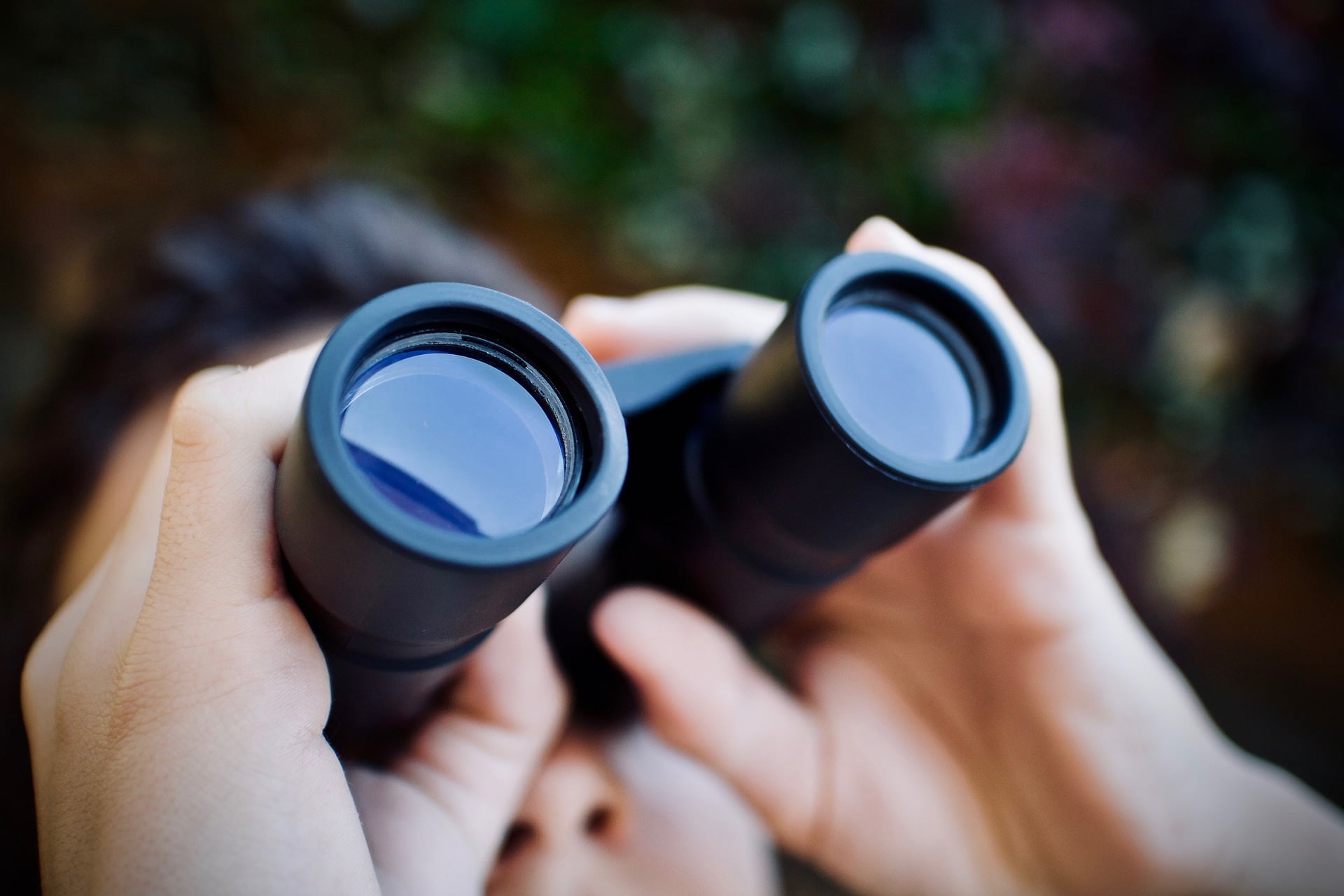
The Bottom Line
Image stabilizing binoculars provide crisp, clear images, even when the object is moving, or your hands are shaking when the zoom is at maximum.
Although all of our seven picks of image stabilization binoculars are of excellent quality and with outstanding features, we’ve picked the Canon 12X36 Image Stabilization III Binoculars as our winner.
They offer an exceptionally wide field of view, high magnification of 12x with a superior image resolution. There’s also their long eye relief, good image stabilization, and very affordable price point to top it all off.
If you’re looking for image-stabilized binoculars suitable for professional use, we would recommend looking into Zeiss Carl Optical 20x60 Image Stabilization Binocular.
Ultimately, it depends on you and your needs and activities you’ll be using them for. With our detailed buyers guide above, you will hopefully find the most suitable pair of image stabilization binoculars for you.










